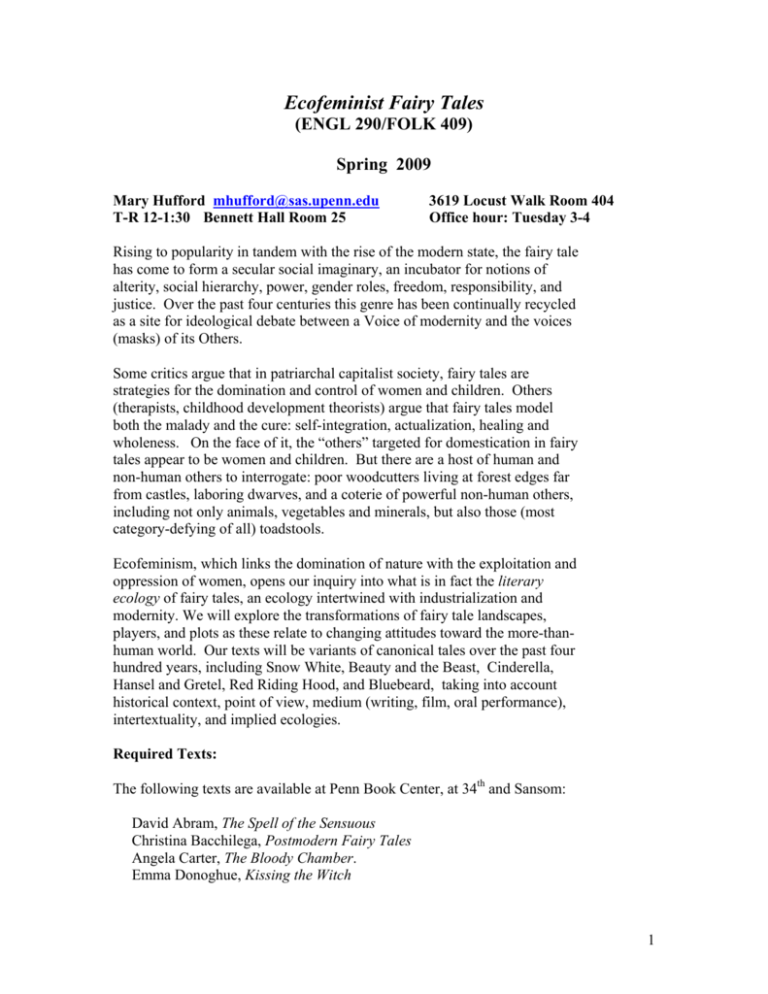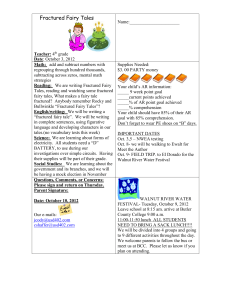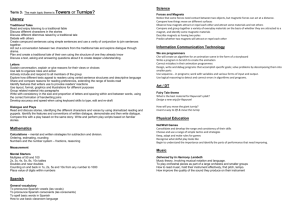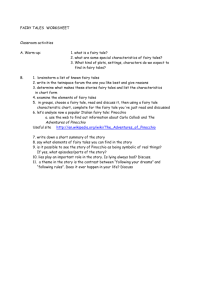Ecofeminist Fairy Tales
advertisement

Ecofeminist Fairy Tales (ENGL 290/FOLK 409) Spring 2009 Mary Hufford mhufford@sas.upenn.edu T-R 12-1:30 Bennett Hall Room 25 3619 Locust Walk Room 404 Office hour: Tuesday 3-4 Rising to popularity in tandem with the rise of the modern state, the fairy tale has come to form a secular social imaginary, an incubator for notions of alterity, social hierarchy, power, gender roles, freedom, responsibility, and justice. Over the past four centuries this genre has been continually recycled as a site for ideological debate between a Voice of modernity and the voices (masks) of its Others. Some critics argue that in patriarchal capitalist society, fairy tales are strategies for the domination and control of women and children. Others (therapists, childhood development theorists) argue that fairy tales model both the malady and the cure: self-integration, actualization, healing and wholeness. On the face of it, the “others” targeted for domestication in fairy tales appear to be women and children. But there are a host of human and non-human others to interrogate: poor woodcutters living at forest edges far from castles, laboring dwarves, and a coterie of powerful non-human others, including not only animals, vegetables and minerals, but also those (most category-defying of all) toadstools. Ecofeminism, which links the domination of nature with the exploitation and oppression of women, opens our inquiry into what is in fact the literary ecology of fairy tales, an ecology intertwined with industrialization and modernity. We will explore the transformations of fairy tale landscapes, players, and plots as these relate to changing attitudes toward the more-thanhuman world. Our texts will be variants of canonical tales over the past four hundred years, including Snow White, Beauty and the Beast, Cinderella, Hansel and Gretel, Red Riding Hood, and Bluebeard, taking into account historical context, point of view, medium (writing, film, oral performance), intertextuality, and implied ecologies. Required Texts: The following texts are available at Penn Book Center, at 34th and Sansom: David Abram, The Spell of the Sensuous Christina Bacchilega, Postmodern Fairy Tales Angela Carter, The Bloody Chamber. Emma Donoghue, Kissing the Witch 1 Carolyn Merchant, The Death of Nature Maria Tatar ed., The Classic Fairy Tales Jack Zipes, ed. Don’t Bet on the Prince All other required readings, along with some recommended readings, will be posted to the course blackboard site, and are marked as (BB) on the schedule. In addition, I will place films and key resources for research papers on reserve in the Rosengarten Reading Room of Van Pelt Library. These are included in the course bibliography, as are reference materials and electronic links. Work for the Course: I. Class Participation (50 percent) This is a seminar-style class, and I expect students to be fully engaged in readings, discussions, and assignments. Come to every class prepared to discuss the assigned readings, and to share responses to two research questions for each of seven fairy tales. 25 percent. Research Questions: This course covers six classic fairy tales over the course of nine weeks. Each fairy tale represents a particular Tale Type from the Aarne-Thompson-Uther Index of International Tale Types. For each, you are required to fill out a comparative spread sheet (posted to the course blackboard) and write a short reflection on the differences and similarities reflected along one vector. Your reflection should describe the point of comparison and contrast, pose a question, and discuss the question in relation to at least one of the assigned critical readings for that tale type (one to two pages each, double spaced, with sources documented) research assignments. You are encouraged to relate these exercises to your larger research project, as a way of arriving at your topic, and as a way of further exploring and refining your approach. In addition, you will be asked to track fairy tales in the news (or in everyday life), and to post two short reports on these to the course blog. Each day check the news for allusions to fairy tales, either generally, or to specific tales, characters, situations, and settings. Write about the allusion, what it means in the context of its use, what new meanings it may contribute to public understandings of fairy tales, and what public assumptions about fairy tales are reflected. If you do hear an allusion in conversation, or in a lecture, or an advertisement, the same questions apply. Please bring texts and related visuals to the class. (1-2 pages each, double-spaced, with citations). II. Final Project: Annotated Fairy Tale Revision OR Critical Study (50 percent) For your final project for this class, you have a choice of writing a fairy tale revision or a criticism of a contemporary fairy tale revision. In either case, you will complete your project in four stages: a proposal (due Tuesday, March 24), a background paper (seven to ten pages double-spaced, plus footnotes and references), an oral presentation of your 2 work in progress (due either the last week of class or during the reading week, TBD), and a final written project consisting of the background paper plus the fairy tale or critical essay. Together the background paper and fairy tale\critical essay should be fourteen – twenty pages in length, plus notes and references. More detailed guidance on each of the four components will be posted to the course blackboard site. The background paper (25 percent of your grade) will lay the foundation for your own ecofeminist tale, script, or poetry (about ten pages, double-spaced) or your evaluation of a contemporary fairy tale adaptation. This research should incorporate historical research related to the setting, events, and characters in your composition or the contemporary adaptations that you will be evaluating. In addition, you should know something about the ways in which your fairy tale has been handled during different historical periods and in a variety of genres, including not only collected oral and rewritten versions of fairy tales, but operas, ballets, graphics, rap versions, tv series, cinematic versions, and any others you can identify. Your final composition (another ten pages double-spaced) (25 percent of your grade) should build logically on your background research, and should integrate that research, either through annotations (see Tatar’s Annotated Classic Fairy Tales) or direct incorporation into a discussion of a contemporary adaptation. One way to develop an ecofeminist approach to your adaptation or evaluation is to look at chronotopes. The idea of the chronotope, drawn from the literary theory of Mikhail Bakhtin, is emerging as a powerful one in the subfield of literary ecology. Examples of Fairy Tale chronotopes include the forest, the castle, the garden, the kitchen, a road, a river, a bridge, a secret chamber and so forth. Chronotopes are kinds of spaces in which particular kinds of things happen (bargains, transformations, riddling, gambling), engaging particular kinds of characters (good, evil, male, female, human, not-human, spirit, matter) and properties (mirrors, brooms, food, apparel, gifts, stolen objects), thereby furthering the plot. Events, characters, and time-spaces are mutually defining and are in turn defined in relation to other chronotopes. For examples of recurrent kinds of events, refer to Vladimir Propp’s thirty one functions of fairy-tales, and the cast of “dramatis personae,” in “The Morphology of the Folktale,” in Tatar’s The Classic Fairy Tales, pp. 382-387. As you develop your ideas, you may also find it helpful to browse the motif and tale-type indexes (on reserve in Rosengarten), as well as the Greenwood Encyclopedia of Folk and Fairy Tales in the reference stacks on the first floor of Van Pelt Library. 3 Schedule of Topics, Readings, and Assignments Thursday, January 15: Introduction Tuesday, January 20: Diverging Frameworks for Development and Transformation: Berman, from All That is Solid Melts into Air: “Goethe’s Faust: The Tragedy of Development.” pp. 37-86 (BB) Merchant, from The Death of Nature: “Women and Ecology,” “Nature as Female,” and “Farm, Fen, and Forest: European Ecology in Transition.” “Organic Society and Utopia;” “The World an Organism;” pp. 1-126. Thursday, January 22: From Organic to Mechanistic Cosmologies Merchant, from The Death of Nature: ”Nature as Disorder,” “Production, Reproduction and the Female,” “Dominion over Nature,” “The Mechanical Order,” pp. 127-215. Abram, from The Spell of the Sensuous: “The Ecology of Magic,” pp. 3-29. Hyde, from The Gift, “Some Food We Could Not Eat,” pp. 3-24. (BB) Tuesday, January 27: Little Red Riding Hood (ATU 333) Tatar, from The Classic Fairy Tales, (TCFT), pp. 3-24. Thursday, January 29: From Psychological to Socio-Historical Contexts Olrik, “Epic Laws of Folk Narrative,” (BB) Zipes, from Don’t Bet on the Prince, “A Second Gaze at Little Red Riding Hood’s Trials and Tribulations,” pp. 227-260. Tuesday, February 3: Postmodern Versions Bacchilega, from Postmodern Fairy Tales (PFT), “Little Red Riding Hood’s Voices in Performance,” pp. 50-70. Carter, from The Bloody Chamber, “The Werewolf,” “The Company of Wolves,’ and “Wolf-Alice.” Thursday, February 5: Introduction to Motifs, Tale Types, and Folktale Morphology Tatar, from TCFT, pp. 373-387 Carter’s Wolf Trilogy, cont. (1st written assignment due) Tuesday, February 10: Beauty and the Beast (ATU 425) Tatar, from TCFT, pp. 25-73 Thursday, February 12: History 4 Warner, From the Beast to the Blonde, “Reluctant Brides,” and “Go! Be A Beast,” pp. 272-318. (BB) Tuesday, February 17: Postmodern Versions Baccilega, from Postmodern Fairy Tales, “In the Eye of the Beholder,” pp. 71102 Carter, from The Bloody Chamber, “The Courtship of Mr. Lyon,” “The Tiger’s Bride,” pp. 41-67. (2nd written assignment due) Thursday, February 19: Snow White (ATU 709) Tatar, from TCFT, pp. 74-100. Warner, From the Beast to the Blonde, “Wicked Stepmothers,” pp. 218-240 (BB) Tuesday, February 24: Gilbert and Gubar, “Snow White and her Wicked Stepmother,” from Tatar, TCFT, pp. 291-297. Coover, Robert, “The Dead Queen.” (BB) Molinaro, from A Full Moon of Women, “Snow White,” (BB) DVD, Tom Davenport, Willa: An American Snow White. (on reserve) Thursday, February 26: Baccilega, from Postmodern Fairy Tales, “The Framing of Snow White,” pp. 2448. Carter, from The Bloody Chamber, “The Snow Child.” Pp. 91-92. Meider, from Disenchantments, Snow White poems, pp. 149-166 (BB) (3rd written assignment due) Tuesday, March 3: Cinderella (ATU 510) Tatar, TCFT, pp. 101-137. Warner, From the Beast to the Blonde, “Absent Mothers,” pp. 201-217 (BB) Thursday, March 5: Yolen, “America’s Cinderella,” from Dundes’ Cinderella: A Casebook, pp. 294306. (BB) Zipes, “Breaking the Disney Spell,” from Tatar, TCFT, pp. 332-352. Meider, from Transformations, Cinderella poems (BB) DVD, Tom Davenport, Ashpet, (on reserve) (4th written assignment due) No Class March 6-16 Spring Break Tuesday, March 17: Discussion of Proposals for Final Projects Thursday, March 19: Bluebeard (ATU 312, 311, 955) Tatar, from TCFT, pp. 138-178. 5 Tuesday, March 24: Atwood, “The Female Body,” and “Alien Territory” (BB) and “Bluebeard’s Egg” (in Tatar, TCFT) DVD: Selznick, “Rebecca” (1940 film adaptation of Daphne Du Marier’s 1938 novel, on reserve) (Proposals due for final projects) Thursday, March 26: Baccilega, from Postmodern Fairy Tales, “Double Agents and Bluebeard’s Plot,” pp. 104-138. Carter, from The Bloody Chamber, “The Bloody Chamber,” pp. 7-41. (5th written assignment due) Tuesday, March 31: Hansel and Gretel (ATU 327) Tatar, from TCFT, pp. 179-197. Bettelheim, from Tatar, TCFT, “Hansel and Gretel,” pp. 273-280. “Gingerbread,” from Buffy the Vampire Slayer TV series http://www.hulu.com/watch/61408/buffy-the-vampire-slayer-gingerbread Thursday, April 2: Screening of : “Hansel and Gretel: An Appalachian Version” Carter, “Penetrating to the Heart of the Forest” (BB) Zipes, “The Rationalization of Abandonment and Abuse in Fairy Tales: The Case of Hansel and Gretel.” (BB) Tuesday, April 7: Ecologies of Writing, Voice, and Chronotope Abram, from Spell of the Sensuous: “Animism and the Alphabet;” and “In the Landscape of Language,” pp. 93-179. McDowell, from The Ecocriticism Reader, “The Bakhtinian Road to Ecological Insight,”pp. 371-91 (BB). (6th Written Assignment due) Thursday, April 9: Ecologies, cont. Selections from Wanning-Harries’ Twice Upon a Time: Tuesday, April 14: Fairy Tale Pastiche Donaghue: Kissing the Witch Thursday, April 16: Donoghue, conclusion. Tuesday, April 21: (no class) and Thursday, April 23: Wrap up discussion Tuesday, April 28 and Thursday, April 30: Presentations of final projects May 7: Final Papers Due 6 ENGL 290: ECOFEMINIST FAIRY TALES GUIDELINES FOR PROPOSALS AND FINAL PROJECTS For your final project for this class, you have a choice of writing a fairy tale revision or a criticism of a contemporary fairy tale revision. In either case, you will complete your project in four stages: a proposal (due Tuesday, March 24), a background paper (seven to ten pages double-spaced, plus footnotes and references), an oral presentation of your work in progress (due either the last week of class or during the reading week, TBD), and a final written project consisting of the background paper plus the fairy tale or critical essay. Together the background paper and fairy tale\critical essay should be fourteen – twenty pages in length, plus notes and references. Guidance on each of the four components follows. 1) The Proposal The proposal should identify a question about human development and transformation that you want to explore through your creative or critical writing. It should identify the Tale Type and a set of possible sources for the versions of the tales and models for creative and critical writing, along with your ideas for developing your research and writing. Here is a check-list of things to cover: a) the tale type and problem\ theme you are interested in exploring through research and creative or critical writing; • the problem or theme should be central to recurring kinds of human relationships (intergenerational, familial etc), but also responsive to changing historical conditions and technologies; • the problem should be linked to the task of development\transformation, and the associated rites of passage; • and the problem or theme will also consider how the rendering of the fairy tale symbolizes and emulates those relationships, experimenting with the removal of impediments to development\transformation through adaptations to the forms and settings (including chronotopes) for the fairy tale itself. b) how the problem in which you are interested is central to the tale type you have selected; c) if you are writing a fairy tale, indicate the possible sources for versions of the fairy tale with which your fairy tale will dialogue; d) if you are writing a criticism, indicate the text(s) you will bring into dialogue with versions of the fairy tale it engages. e) if you know which versions of your tale type you plan to engage, please list them; if not, identify resources that will lead you to those versions. The number of versions you assemble is up to you, but each paper should clearly demonstrate awareness of versions of the tale type from the following sources: -- oral narrative settings; -- pre-19th century literary versions; -- nineteenth century versions in any medium (prose narrative, poetry, opera, ballet, or visual art); -- twentieth century cinema; -- contemporary (1970s to the present) literary versions (poetry, novel, or short story). The course bibliography is the best place to begin your research, as many of the versions and variants are already assembled in the critical writings of Zipes, Baccilega, Tatar, Warner, and others. You are encouraged to engage versions we have used in class as well as on versions you find on your own. f) if you are writing a fairy tale, indicate the time and setting in which you are thinking of situating your tale, and any sources on which you might rely for information about this time and setting. g) whether you are proposing to write a fairy tale or a critical essay, indicate the techniques and strategies of writing that you are interested in using or studying, and models from course readings: for example, framing, mirroring, narrative voice, shifting focalization, insertion of genres, the use of Olrik’s Epic Laws, and the use of intra- and inter-textual allusion to intensify meaning. The proposal should be 3-5 pages, double spaced, plus references. Please post the proposal to the course blog on the assignment page, and read the proposals of your classmates. As you develop your own research, use the blog comment function to share information about resources you encounter that might be useful to your classmates, and share constructive suggestions in response to requests for such that your classmates may post. 2) Background Paper The background paper (seven to ten pages) will set the stage for your own fairy tale or critical essay. It will provide an overview of the tale type and the way in which its variants have dealt with the problem in which you are interested, engaging related criticism (from Baccilega, Zipes, Warner, and others in the bibliography) addressing the bearing of form and context on the meanings and functions of the versions. It will also provide necessary background on the setting you have chosen for your fairy tale, the development of your thinking about your approach to the problem, and your version will illuminate and resolve old questions and raise new ones. Once you have assembled the variants of the tale, please construct a spreadsheet comparing the ways in which variants of the tale have approached the problem you are thinking about. Please e-mail your spreadsheet to me by Tuesday April 7. I will allocate class time for discussing your works in progress on Thursday, April 9. Apart from class discussion, please post questions to the blog, and participate actively on the blog, using the comment function to share constructive ideas with and request input from your classmates. 3) Oral Presentations: You will deliver a 15 to 20 minute oral version of your fairy tale or your criticism. We can either allocate the last three classes to this, or cancel the last two classes, and instead hold a three hour mini-conference during reading week, with a program and refreshments, in a space that I will procure for the occasion. We will talk about this in class. 4) Final Papers: The final submission will consist of your background paper plus the fairy tale or critical essay. Together the background paper and fairy tale\critical essay should be fourteen – twenty pages in length, plus notes and references. It is due to me electronically and in hard copy by noon on May 7. (Please turn the hard copies in at the English Department office for placement in my mailbox). Ecofeminist Fairy Tales (ENG 209 FOLK 491) Course Bibliography * = Placed on reserve in Van Pelt Library’s Rosengarten Reading room. ** = In reference collection at Van Pelt Library Abram, David. 1996. The Spell of the Sensuous: Perception and Language in a Morethan-Human World. New York: Random House. Baccilega, Christina. 1997. Postmodern Fairy Tales: Gender and Narrative Strategies. Philadelphia: University of Pennsylvania Press. Bakhtin, Mikhail. 1982. The Dialogic Imagination. Austin: University of Texas Press. * --------. 1984. Problems of Dostoevsky’s Poetics. Minneapolis: University of Minnesota Press. Benjamin, Walter. 1969. Illuminations: Essays and Reflections. New York: Schocken. Berman, Marshall. 1988 [1982]. “Goethe’s Faust: The Tragedy of Development.” All that is Solid Melts into Air: The Experience of Modernity. New York: Penguin, pp. 37-86. Bottigheimer, Ruth. 2009. Fairy Tales: A New History. Albany: State University of New York Press. Carter, Angela. 1979. The Bloody Chamber. New York: Penguin. Darnton, Robert. 1984. “Peasants Tell Tales: The Meaning of Mother Goose.” In The Great Cat Massacre and Other Episodes in French Cultural History. New York: Basic Books, Inc. pp. 3-73. * Donoghue, Emma. 1997. Kissing the Witch: Old Tales in New Skins. New York: Harper Collins. Dundes, Alan. 1982. Cinderella: A Casebook. Madison: University of Wisconsin Press.* --------. 1989. Little Red Riding Hood: A Casebook. Madison: University of Wisconsin Press. Fagan, Brian. 2008. The Great Warming: Climate Change and the Rise and Fall of Civilizations. New York: Bloomsbury Press. * Federici, Sylvia. 2004. Caliban and the Witch: Women, the Body, and Primitive Accumulation. Brooklyn: Autonomedia. * 1 Glotfelty, Cheryll and Harold Fromm. 1996. The Ecocriticism Reader: Landmarks in Literary Ecology. Athens: University of Georgia. * Haase, Donald. 2004. Fairy Tales and Feminism: New Approaches. Detroit: Wayne State University Press. * --------. 2008. Ed. Greenwood Encyclopedia of Folk Tales and Fairy Tales. Westport, CT: Greenwood Publishing Group. ** Harries, Elizabeth Wanning. 2001. Twice Upon A Time: Women Writers and the History of the Fairy Tale. Princeton: Princeton University Press. * Hengen, Shannon. 2006. “Margaret Atwood and Environmentalism.” In The Cambridge Companion to Margaret Atwood. Cambridge: Cambridge University Press, pp. 72-85. Hufford, Mary. 2003. “Interrupting the Monologue: Folklore, Ethnography, and Critical Regionalism.” Appalachian Studies. --------. 2004. “Knowing Ginseng: The Social Life of an Appalachian Root.” Cahiers de Litterature Orale. 53-54: 265-92. --------. 2005. “Ramps, Ramp Suppers, and the Integrity of ‘The Mountains.’” In Cornbread Nation III: The Best of Writing about Foods of the Mountain South. Ed. Ronni Lundy. Chapel Hill: University of North Carolina Press. --------. 2006. “The Aesthetic Ecology of an Appalachian Morel.” In Cornbread Nation IV: The Best of Writing about Foods of the American South. Athens: University of Georgia Press. Hyde, Lewis. 1983. The Gift: Imagination and the Erotic Life of Property. New York: Vintage Press. Jones, Stephen Swann. 2002. The Fairy Tale: Magic Mirror of the Imagination. New York: Routledge. * Merchant, Carolyn. 1999. Ecology: Key Concepts in Critical Theory. Amherst, New York: Humanity Books. * -------. 1990 [1980]. The Death of Nature: Women, Ecology, and the Scientific Revolution. New York: Harper Collins. Mieder, Wolfgang. Disenchantments: An Anthology of Modern Fairy Tale Poetry. University of Vermont. * Murphy, Patrick D. 1995. Literature, Nature, and Other: Ecofeminist Critiques. Albany: State University of New York Press. * 2 Plumwood, Val. 2002 [1993]. Feminism and the Mastery of Nature (Opening Out). New York: Routledge. Ragan, Kathleen. 1998. Fearless Girls, Wise Women and Beloved Sisters: Heroines in Folktales from Around the World. New York: W.W. Norton and Company. Rohrich, Lutz. 2008. “And They Are Still Living Happily Ever After:” Anthropology, Cultural History, and Interpretation of Fairy Tales. Burlington, VT: University of Vermont. * Ruck, Carl A.P. et al. 2007. The Hidden World: Survival of Pagan Shamanic Themes in European Fairytales. Durham, N.C.: Academic Press. * Ruskin, John. 2003 [1841]. King of the Golden River and Other Stories. Whitefish, MT: Kessinger Publishing. Shuman, Amy. 1993. “Gender and Genre.” In Feminist Theory and the Study of Folklore, ed. Susan Hollis, Linda Pershing, and M. Jane Young. Urbana: University of Illinois Press, pp. 71-88. Stewart, Susan. 1984. On Longing: Narratives of the Miniature, the Gigantic, the Souvenir, the Collection. Baltimore: Johns Hopkins University Press. -------. 1994. Crimes of Writing: Problems in the Containment of Representation. Durham: Duke University Press. Tatar, Maria. 1999. The Classic Fairy Tales. New York: W.W. Norton. --------. 2002. The Annotated Classic Fairy Tales. New York: W.W. Norton. * Warner, Marina. 1994. From the Beast to the Blonde: On Fairy Tales and Their Tellers. New York: Farrar, Straus and Giroux. * -------. 1998. Monsters of Our Own Making: The Peculiar Pleasures of Fear. Lexington: University Press of Kentucky. * Warren, Karen J. 2000. Ecofeminist Philosophy: A Western Perspective on What It Is and Why It Matters. New York: Rowman and Littlefield. * Zipes, Jack. 1986. Don’t Bet on the Prince: Contemporary Feminist Fairy Tales in North America and England. New York: Methuen. * --------. 1983. Trials and Tribulations of Little Red Riding Hood: Versions of the Tale in Sociocultural Perspective. South Hadley, MA: Bergin and Garvey. 3 --------. 2002 [1979]. Breaking the Magic Spell: Radical Theories of Folk and Fairy Tales. (Revised and expanded edition). Lexington: University Press of Kentucky. * Online Resources: SurLaLune Fairy Tales.com: http://www.surlalunefairytales.com/index.html (contains many texts, annotations, resources, and links) Tales Online: www.talesunlimited.com (Van Pelt library is looking into a subscription; meanwhile, you may take advantage of a free trial subscription). Journals: In addition to a number of journals devoted to folklore scholarship available online, there is an online journal devoted to the study of Fairy Tales: Marvels and Tales: The Journal of Fairy Tale Studies http://www.langlab.wayne.edu/MarvelsHome/Marvels_Tales.html 4






